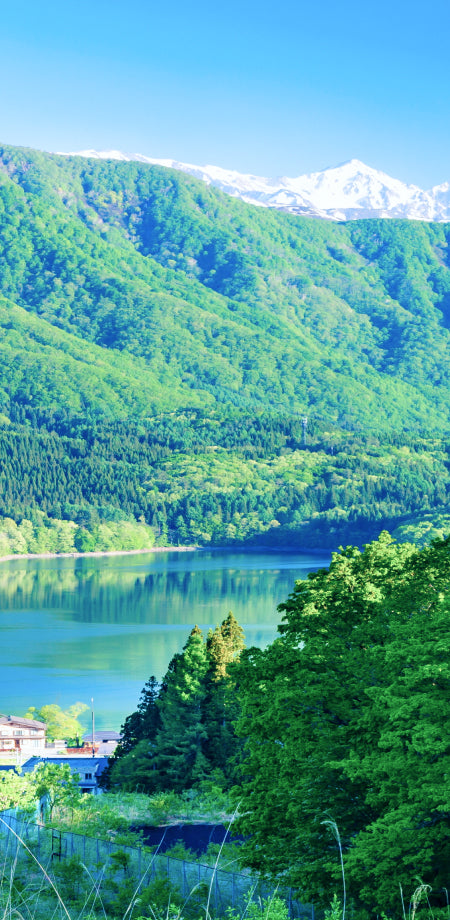投稿日:
更新日:
Sealess prefecture ShinshuThe world of river fish encountered in

An inland prefecture surrounded by eight prefecturesShinshu. Although there is no sea, it has rich and pure water resources that create the source of major rivers such as the Shinano River, Kiso River, and Tenryu River. The bounty has grown freshwater fish such as char, carp, ayu, smelt, and eel, and has become a food culture unique to mountainous lands.
Rainbow trout, char, yamame,ShinshuThe aquaculture industry is also active, with the highest production of trout such as salmon in the country.ShinshuThere was a passion for fish that is unique to a prefecture without the sea.

It has an attractiveness that saltwater fish do not haveShinshuBranded fish
The idea of "fish that are typical of mountain country" was bornShinshuSalmon·ShinshuThe Great King Iwana
Supporting the trout farming industry, Japan's number one, is the one that supplies eggs and juveniles, and is involved in developing and researching fish. Nagano Prefectural Fisheries Experiment Station.ShinshuIn response to the demand for a unique fish, it was developed over a period of about 10 years.ShinshuIt's salmon.
"In the beginning, we were aiming to increase the size of rainbow trout so that we could utilize the equipment and technology of traditional rainbow trout farming, but similar research has increased throughout the country, making it difficult to produce unique colors and prone to illness. So we changed our thinking and crossed rainbow trout with disease-resistant brown trout. The advantages of both were inherited.ShinshuIt's salmon," Furuhata explains the story.

In recent years, it has been a new farmed variety of char, known as the king of mountain streams.ShinshuThe Great King's Sardines are also developed. The characteristics of the large sardines with a firm, delicious flavour have been strongly inherited. "ShinshuIf you're here, I hope you'll enjoy some of the fish that are typical of Yamanobu." Furuhata said. The feeling of hospitalityShinshuIt is evolving the fish culture.
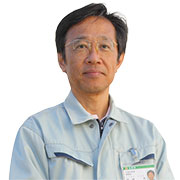
Nagano Prefectural Fisheries Test Center
Furuhata Mitsuru, Head of Proliferation
ShinshuFuruhata was also involved in the development of salmon. "I've been fishing in the Sai River since I was a child, so rainbow trout is a familiar fish. I was in the Biology Club and Fish Group in high school. I've always loved fish," he says.
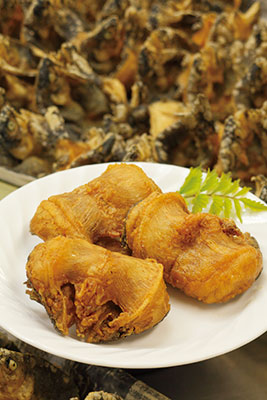
This new specialty of Azumino, "Tsuburaage" will truly surprise everyone.
Rainbow trout cuisine created in Azumino, a spring-spring village
Azumino is said to be the birthplace of rainbow trout farming in Japan. The reason for this is the pure spring water that hydrates the area. The underground water, which is sourced from the melted snowwater of the Northern Alps, maintains a constant amount and cold, providing an ideal environment for trout farming.
Rainbow trout was once a popular fish, but lifestyles have changed, with the likelihood of cooking that is less time-saving and the increasing use of apartments, and the consumption of fish itself has been declining due to the development of distribution networks.
In this situation, President Masao said, "I wondered if there was a way to get people to eat river fish, so I asked my wife if I could make some new side dishes."
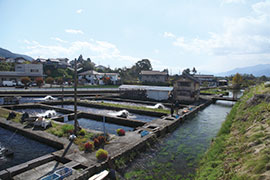
Tamiko, who loved cooking, devised "Fried Enge" inspired by local cuisine, which involves frying turtles and crucian carp twice. "It didn't sell well at first, but when I tried it, everyone was surprised and said, "This is delicious!" Tamiko said. Thanks to the steady efforts, we now sell over 1,500 units every day. It is also very nutritious and is loved as a new specialty of Azumino, which is also used in school lunches.
Freshness is life! Until "Fried Engel"
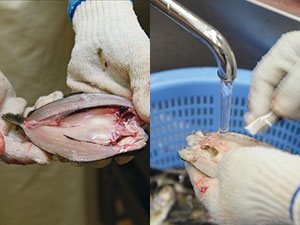
Open back and get blood
Rainbow trout that has been lifted from the pond is immediately opened on a special machine and each plant is hand-held to create blood. It seems that removing the internal organs and washing them with water is also a factor in creating odorless fried chicken.
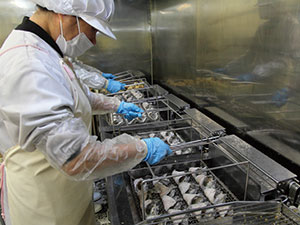
Once fry it, it's frozen
Once the pre-treatment is complete, drain the water, sprinkle with flour, arrange on a net to align the shapes and fry in oil at 160°C for about 5 minutes. Once it's fried, you think it's finished, but then go to the freezer. This will remove unnecessary moisture.
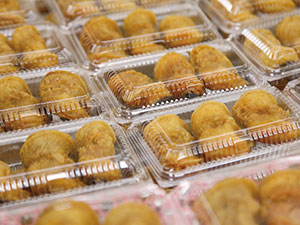
Fry twice and season
Place the frozen fried chicken again in the oil and fry twice. This is why it has a crisp texture even to the bones. Finish with an original soy sauce based sauce and season it. It will be shipped to the local supermarket.

Tatsumi (Azumino City)
Representative Director Takahara Masao and Director Tamiko
Masao, who graduated from fisheries school and has been taking over the family business since the age of 18 as the third generation, and Tamiko, the couple, is mainly in charge of producing side dishes. We run the company in a harmonious and harmonious manner.
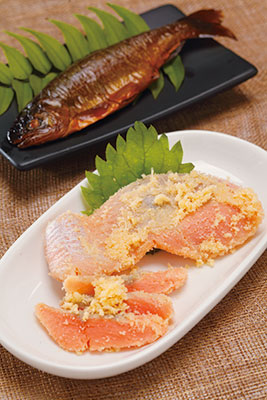
"Masunohana Pickled" is a delicious dish that goes beyond the boundaries of river fish.
The Kiso water system that nurtures life will enhance the deliciousness of fish
Around 1939, it is said that Tazawa from Kiso was the first Japanese to start a private trout farming industry. The mainstream farming in Kiso is to use mountain river water, so it is essential to respond according to the weather.
"When it rains heavily, we go and check the pond even in the middle of the night and scour the mud that has accumulated at the source. It's a lot of hard work because it's a natural and living thing, but that makes the fish taste different. I'm confident that I can't beat," says the third generation Masaki.
The original Masuno Hanazuke made Tazawa Trout Farm known throughout the country. In fact, when Masaki's mother, Yoshiko, created and served it as a dish to serve it at the first memorial service, it has received a great reputation and is now available in a commercial product. It later won the grand prize at the National Product Exhibition held at Makuhari Messe, and became a masterpiece that was recognized by department store buyers.

"Kiso is also designated as a forest conservation area, and its water is really good. I want to convey more about the deliciousness of rainbow trout in this area," the whole family said, "The whole family said.
Until "Masunohana-kazuke" was made
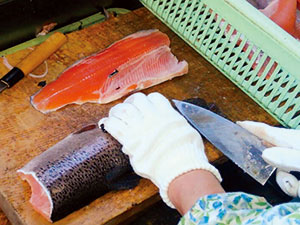
Grate and fillet
Grow three large, fresh rainbow trout into pieces to remove the bones and form fillets. I used to use small rainbow trout, but I used to work.TimesApparently they changed to a larger rainbow trout because of this.
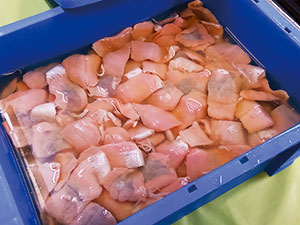
Soak in vinegar and leave overnight
Once you have finished preparing the fillets, first squeeze the meat by dipping it in salt and draining it, then soak it in vinegar and let it sit overnight. No coloring or preservatives are used, making use of the flavor of the ingredients.
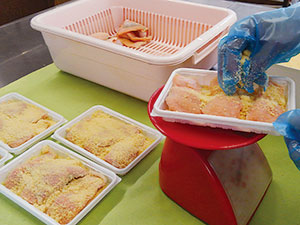
Match with the sardine flowers
"Okara" purchased from a tofu shop in Kiso Fukushima is seasoned with a vinegar-based seasoning and then combined with the fillets to complete. It is perfect not only for side dishes at the dining table, but also for side dishes with sake and chirashi sushi.

Tazawa Trout Farm (Okuwa Village)
Tazawa Masaki
By working in food jobs in Tokyo, interest in the family business grew, and for about 15 years he began working as a third generation farmer. What's going forward?ShinshuHe also tries his hand at developing new products using salmon, and says he wants to share the appeal of river fish.















